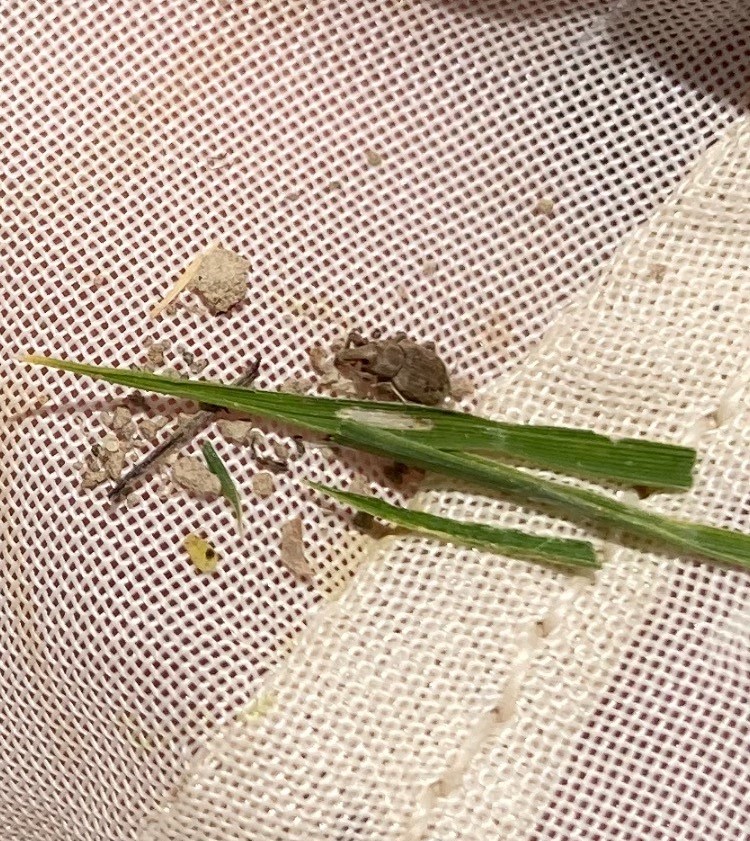Chasing the flood: Arkansas rice growers should be on the lookout for rice water weevils
With rice fields across the state going to flood, rice water weevils are making their appearance, and the window of opportunity for control is short.
By Sarah Cato
U of A System Division of Agriculture
May 28, 2024
Fast Facts:
- Rice water weevils popping up in early-planted rice fields in flood
- Window of opportunity for control is short
- Growers should be scouting immediately after flooding rice fields
(481 words)
(Newsrooms: Download photo of rice water weevil and leaf scarring.)
STUTTGART, Ark. — With rice fields across the state going to flood, rice water weevils are making their appearance, and the window of opportunity for control is short.

“We’re seeing high populations of rice water weevils from Stuttgart up through Jonesboro in early planted rice that has already gone to flood,” said Nick Bateman, extension entomologist for the University of Arkansas System Division of Agriculture. “We’ve got a pretty short window where we can really do something about adult populations, so we need to make sure we’re chasing the flood and scouting.”
If adult rice water weevils are present, foliar insecticide applications must be made within five to seven days of flood establishment to achieve maximum control. Alternative methods are costly.
“If we miss the window for adult control with an insecticide, our only other option is to drain the field until the soil cracks to kill the larvae,” Bateman said. “But in doing that, we’re looking at adding in herbicide applications, fertilizer and the cost of diesel to re-flood the field. We really want to catch the adults early and get them with an insecticide application.”
Knowing when to spray
While older recommendations have depended on the presence of leaf scarring to indicate rice water weevil pressure, Bateman says this method is not dependable.
“We’re now recommending people look for adults in the field,” he said. “We’ve seen a similar amount of scarring on fields with light pressure and heavy pressure, so that really isn’t the best indicator of population. Folks can take a sweep net and determine adult populations.”
Because rice water weevils favor open water, Bateman recommends sweeping 50 to 60 feet away from levee furrows to get an accurate idea of populations. A threshold based on presence of adults is currently in the works, but growers should be prepared to spray a foliar insecticide if there is a high population of adults present.
“Your only two options are to either spray a product like Lambda-Cy or Warrior II, which will give about 60 percent control, or we can spray Belay, a nicotinoid,” Bateman said. “But with a third tiller cutoff, Belay may not be an option.”
Bateman recommends keeping rice water weevils in mind when choosing rice seed each year. While most rice planted in the state has been treated with a neonicotinoid, like Cruiser, Bateman suggests overtreating that seed with a diamide, such as Fortenza or Dermacor.
“It doesn’t take a huge population of adults to lay enough eggs to really start costing you money,” Bateman said. “Combining two seed treatments may be costly, but from the work we’ve done, we’ve seen that these products easily pay for themselves. And protect bushels that we don’t realize we’re losing.”
Insecticide recommendations for rice in Arkansas can be found in the MP144.
Mention of product names does not imply endorsement by the University of Arkansas System Division of Agriculture.
To learn about extension programs in Arkansas, contact your local Cooperative Extension Service agent or visit www.uaex.uada.edu. Follow us on X and Instagram at @AR_Extension. To learn more about Division of Agriculture research, visit the Arkansas Agricultural Experiment Station website: https://aaes.uada.edu. Follow on X at @ArkAgResearch. To learn more about the Division of Agriculture, visit https://uada.edu/. Follow us on X at @AgInArk.
About the Division of Agriculture
The University of Arkansas System Division of Agriculture’s mission is to strengthen agriculture, communities, and families by connecting trusted research to the adoption of best practices. Through the Agricultural Experiment Station and the Cooperative Extension Service, the Division of Agriculture conducts research and extension work within the nation’s historic land grant education system.
The Division of Agriculture is one of 20 entities within the University of Arkansas System. It has offices in all 75 counties in Arkansas and faculty on five system campuses.
Pursuant to 7 CFR § 15.3, the University of Arkansas System Division of Agriculture offers all its Extension and Research programs and services (including employment) without regard to race, color, sex, national origin, religion, age, disability, marital or veteran status, genetic information, sexual preference, pregnancy or any other legally protected status, and is an equal opportunity institution.
# # #
Media Contact:
Sarah Cato
scato@uada.edu
870-815-9035